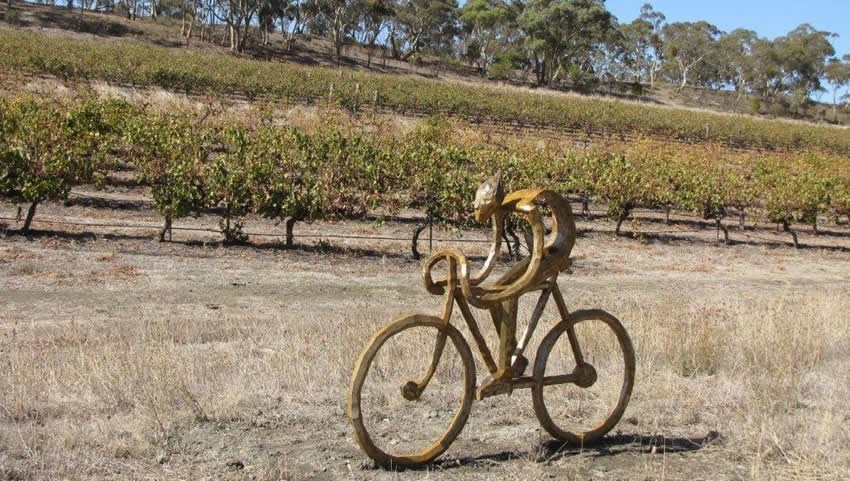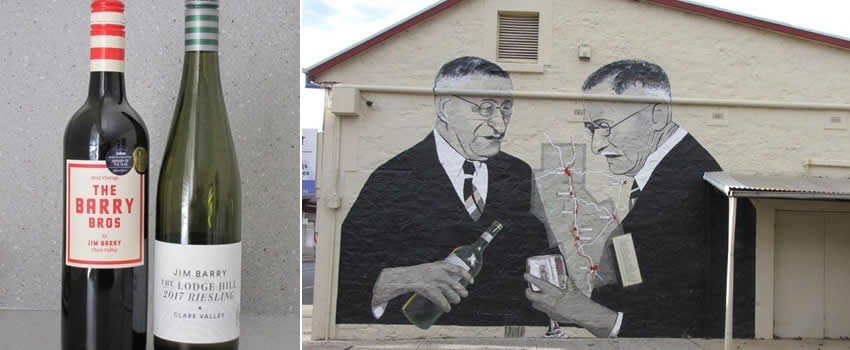Cycling on the Riesling Trail along the route of an old railway track, we spotted tempting signposts to some of the thirty-five cellar doors in the Clare Valley. The thirty-three kilometer trail from the towns of Barinia to Auburn runs through the heart of Riesling country, passing along the valley floor through a long avenue of blue gums past gnarly old vineyards rolling away into the hills. I stopped to read the storyboards along the way which tell the 19th century history of settlement. An enterprising group of local winemakers opened the route in 1994 to promote wine tourism to Clare. You can cycle, jog, walk or even push a pram along this gentle undulating ramble through the valley.

Although the Clare Valley accounts for only 21 500 tons of grapes from 5000 hectares – a tiny percentage of the annual crush in Australia – the locals will proudly tell you this premium boutique wine region wins 20% of the national wine awards. Pioneered by British settler John Horrocks who planted the first vines in Clare in 1942 – the Riesling trail runs right past his heritage house – the valley is home to the oldest wine farm, Sevenhill Cellars (1851) owned by the Jesuit Brothers which makes 90% of the sacramental wine in Australia - as well as wines from old Shiraz and Grenache vines.
We cycled up the hill to Skillogalee, one of the many small family cellars which emerged out of the boutique boom in Clare Valley in the 1970s. Owners winemaker David Palmer and chef Diana Palmer have made the rustic old homestead a food and wine destination over the course of the last 27 vintages they’ve made. Named after the Irish term for a thin gruel – the staple diet of the original nineteenth century settlers who raised 17 children here – the food is a showcase for Clare produce from the farm’s own honey, veg and fruit (try the fig, goats’ cheese and prosciutto starter) to the vintners platter or duck and peach salad. After a ten- kilometre ride, we were hungry and thirsty. (The entire trail has gentle gradients, varies from 300 – 465 metres and takes around 3-5 hours.)
Skillogalee specialises in four styles of Riesling – sparkling, standard, Trevarrick (listed in Matthew Jukes Top 100 Australian wines 2017) and late harvest. We enjoyed a refreshing glass of the bottle-fermented Riesling aged on its lees for thirty months while relaxing on the terrace of the regional winner of best winery tourism restaurant in the Great Wine Capitals Awards 2017. The best wine of the tasting was The Trevarrick Single Contour Riesling 2015 – each contour block on the farm is harvested and vinified separately – made from the highest altitude vines which express the minerality of the dolomite soils in which they are grown. The tasting notes on the label were quirky – describing the wine as “an intense lift of Tahitian lime, bath powder and floral perfume”.
We set out to explore some of the distinct flavours of the sub-regions of Clare Valley which David Palmer described – the leaner, steely, mineral notes of Riesling grown in schist and slate soils on one side of the valley versus the riper, fuller flavoured flavours of Riesling in loam and limestone soils on the other. I was on a learning curve into liquid geography on my rollercoaster ride through Riesling country. The vineyards of Watervale and Leasingham produce an aromatic, dry style of Riesling with delicate floral nuances; the cooler, slate soils of higher-lying Polish Hill River shape an austere old-world mineral style; and the warmer, lower valley floor leans to a fuller, riper style of fresh lime fruit. The kings of Clare Riesling are Grosset, Jim Barry, O’Leary Walker, Pikes, Sevenhill, Taylors and Tim Adams.

We pedalled off on a little loop to visit Kilikanoon, racking our bikes outside another old stone farmhouse built by the early pioneers of Clare. Named by the original Cornish owner after the Celtic word for “nut grove on the down”, Kilikanoon is renowned for its red wines – ever since its Oracle Shiraz won Best Shiraz in the World at the International Wine Show in London in the early 2000s. Owner winemaker Kevin Mitchell (since 1997) specialises in Rhône varieties. He makes a wide variety of site-specific Shiraz under his Covenant, Killerman, Oracle – and flagship Attunga 1865 Shiraz from some of the oldest vines in Clare. In the revelation room we tasted inter alia a maiden single varietal Attunga Mataro (Mourvedre) and premium Kelly 1932 Grenache made from some of the oldest vines in Clare. No wonder James Halliday named Kilikanoon Winery of the Year in 2013.
Sevenhill, the oldest winery in Clare Valley, is a landmark on the Riesling Trail. First planted in 1851 by Jesuit Brothers fleeing religious persecution in Silesia (old Prussia), the farm is renowned for old pre-1860 Shiraz vines planted pre-phylloxera – and for its magnificent stone church, crypt, hand-hewn cellar and old slate wine tanks. Seventeen varieties are planted on 95 hectares of vineyards today – the source of the award-winning wines made by Brother John May, the chief winemaker who made thirty vintages before retiring in 2003. We tasted the Sparkling Riesling, Inigo Grenache, St Ignatius (a Bordeaux blend) and Brother John May Reserve Shiraz, a flagship made from old vines. The only Jesuit-owned winery in Oz – rated a coveted five-star winery by James Halliday’s Wine Companion - is protected by saints, shrines, its Madonna of the vines and its first female winemaker.
By the time we cycled back to our lodgings in Clare, an imprinted saddle in my bruised bum made me feel like I had been riding a rodeo all day. After a restorative glass or three of Jim Barry’s spectacular five-star The Lodge Hill Riesling, we ended up at Seed Winehouse, one of the top fine dining venues in Clare. Over a wonderful degustation menu of smoked salmon, crab linguine Nero and farm chicken with mushroom broth, we sampled Clare Penna Lane Riesling and Jim Barry’s Assyrtiko 2017 – made from cuttings brought in from Santorini by Peter Barry after he visited there in 2008. He wrote, “Ässyrtiko is to Santorini what Riesling is to Clare. I like the fresh, crisp, acidic qualities of the wine as well as its low pH and steely backbone.” And we didn’t have to pedal home.
Graham Howe attended the Australian Tourism Exchange 2018 in Australia as a guest of Tourism Australia (www.australia.com), South Australian Tourism Commission (see www.southaustralia.com), www.clarevalley.com.au, www.tourdevines.com and www.clarevalleytours.com